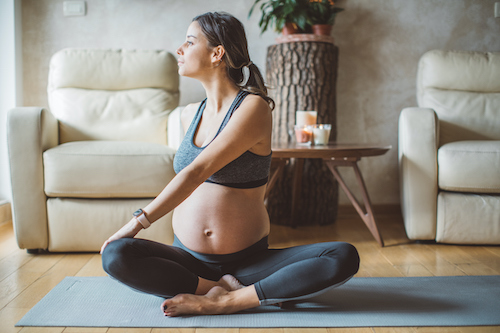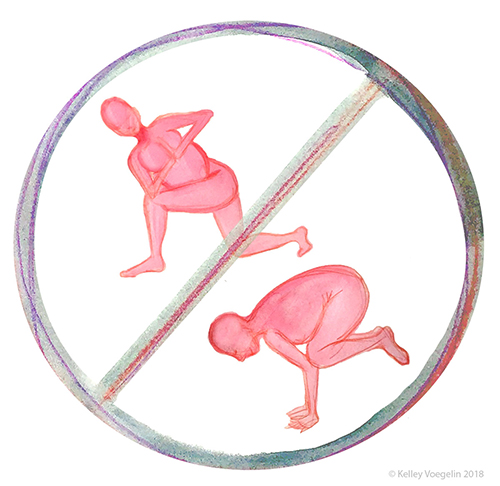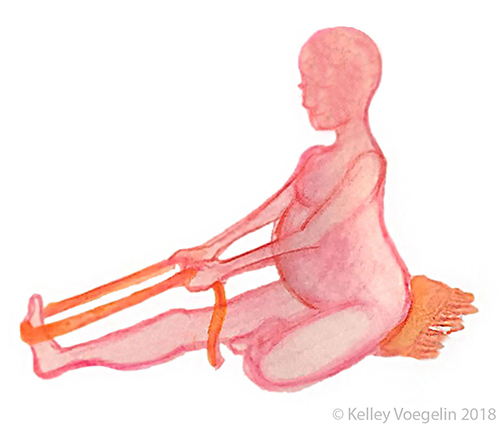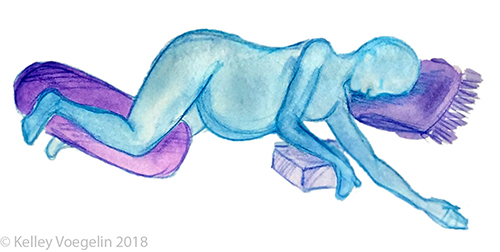In the wee stages of pregnancy — even if you don’t look like you’re expecting yet—you should still avoid certain yoga practices. Furthermore, what feels good for the mom may not be good for the baby.

Using a little extra caution to protect the uterus is the way to practice yoga during this time. Your practice doesn’t need to come to a screeching halt — quite the contrary.
Yoga during pregnancy is loaded with physical, mental and energetic benefits so keep doing it safely as long as you can. Just be aware of the best, safest ways to align your practice with your ever-changing body in pregnancy.
Practices to avoid

Moms-to-be can still participate in a prenatal yoga practice, but there are a few poses and shapes you want to avoid during pregnancy:
- Twists that cross against the belly.
- Belly-down poses, like Locust, Bow, Cobra and Sphinx, that put pressure on the womb.
- Supine poses, especially those that last too long. These can put pressure on the inferior vena cava and can make you feel lightheaded or dizzy. Omit supine poses, and add side-lying or reclining poses on bolsters.
- Inversions, without the support of a wall. Also omit pike and jumping because they can affect the womb.
- Forward bends, with legs squeezed too tightly together and the belly against thighs.
- Extreme back bends, like Wheel and Upward-Facing Dog can overstretch the belly.
- Extreme core work and arm balances, like Boat, Crow, etc.
- Breath retention.
- Kappalabhati/Bhastrika Pranayama, aka “Breath of Fire.”
- Uddiyana Bhanda, because you have to draw in the belly deeply.
- Nauli, because it requires too much “churning” in the belly area.
Now, let the practice of yoga begin!
Each trimester has its own unique focus
As your body changes over the course of 9 months plus, you can adapt your yoga practice to accommodate your needs. In fact, yoga is sustainable for anybody, at any stage if you just keep listening to your body.
For each trimester of pregnancy, your yoga body focuses on different things:
- First trimester: embrace rest and focus on keeping the womb secure by not twisting against, pressing on or overstretching the uterus and the new fetus.
- Second trimester: welcome the big changes going on with renewed energy and build your connection with the baby. Mom aims to create space in the torso, stabilize the pelvis and strengthen the pelvic floor.
- Third trimester: address the ever more imminent arrival of the baby on emotional, energetic and physical levels. Move and rest in ways that create space in the upper body and pelvis. Acknowledge your changing endurance levels, practice breathing techniques, and prioritize whatever allows you to grab much coveted rest.
Modifying your practice for comfort and safety
While there are many specific modifications you can make for your yoga practice,the offerings below are general tips to keep in mind:
Standing Poses
Make sure your feet and legs are really well grounded, especially when entering standing postures or lunges. Always make space for the pelvis and the little one growing inside. So, to accommodate for the extra space, place your feet in a wider stance for Warrior One and lunges — think of the feet as being on “railroad tracks.”
It’s okay to enter standing asana from Mountain, because at some point, entering most postures from Downward Facing Dog becomes exhausting, uncomfortable and unnecessary.
The Vinyasa
It’s okay to let go of the flow that most classes include: Downward Dog, Plank,Chaturanga Dandasana, Upward Facing Dog and back again. My nutshell recommendation is to modify this portion of class with your knees on the floor in Plank and Cat/Cow movements.
Forward Bends
Seated forward bends can be done on blankets, with a strap to loop around your feet,to help you keep a long spine and an open chest. We don’t fully fold onto the legs,anyway, even if the belly is not big yet!
Standing forward folds also require the “flat” back. In poses like Standing Forward Fold, Pyramid or Wide Legged Forward Bend, have your hands on blocks and keep your spine parallel to the ground.
Seated Poses
Seated postures can be done against a wall, on a stack of blankets or with a bolster.
Back bend Poses
While opening the heart is a key goal, you don’t want to compress the lower back or overstretch the belly. Approach these shapes with support, i.e. Camel with hands on the low back instead of the heels or Fish with blocks under the head and shoulders.Just focus on opening the chest.
Never underestimate the power of restorative back bends, like Reclining Bound Angle— this pose wins the gold in every single prenatal class I teach.

Twists
Seated or standing twists are easily modified by twisting gently in the opposite direction of the non-pregnant yogis. Think: open belly, open heart, open twist.
Restorative poses and Savasana
Restorative poses allow for mom-to-be to rest and rejuvenate her mind and body with support, ease and very little effort. Mamas look forward to the spaciousness and quietude these poses offer.
It is recommended that you lie on your left side during Corpse, especially if you feel dizzy on your back. Elevating the spine, feet or legs is also an option. Use as many props as needed to ensure comfort, support and relaxation.

Yoga props
Yoga props are your friends! Use them all — blocks under the hands; blankets under the seat; a bolster to lie on; a strap for any seated fold. This is the time to give up striving and pushing, to receive support and to accept change.
The ultimate intention of your prenatal yoga practice
A prenatal yoga practice is an opportunity for the mom-to-be to connect with her breath, body, mind and baby. The intention is to keep the womb a safe and secure home for her baby, while making extra space within her own body as the baby grows. Asana supports a strong and supple body, while meditation and breath work calm the mind, heart and nervous system amidst all that is going on inside and around her body.
 |
Discover how to stay motivated to mediate. |










